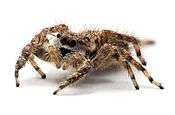Spider web
A spider web, spiderweb, spider's web, or cobweb (from the archaic word coppe, meaning "spider")[1] is a structure created by a spider out of proteinaceous spider silk extruded from its spinnerets, generally meant to catch its prey.
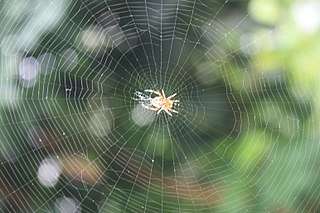
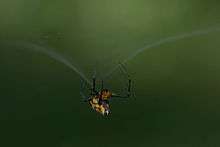
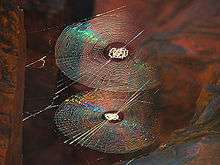
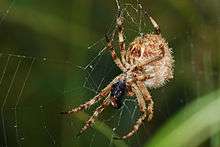
Spider webs have existed for at least 100 million years, as witnessed in a rare find of Early Cretaceous amber from Sussex, southern England.[2] Many spiders build webs specifically to catch insects to eat. However, not all spiders catch their prey in webs, and some do not build webs at all. "Spider web" is typically used to refer to a web that is apparently still in use (i.e. clean), whereas "cobweb" refers to abandoned (i.e. dusty) webs.[3] However, the word "cobweb" is also used by biologists to describe the tangled three-dimensional web[4] of some spiders of the family Theridiidae. While this large family is known as the cobweb spiders, they actually have a huge range of web architectures; other names for this spider family include tangle-web spiders and comb-footed spiders.
Silk production
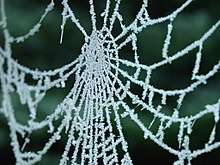
When spiders moved from the water to the land in the Early Devonian period, they started making silk to protect their bodies and their eggs.[3][5] Spiders gradually started using silk for hunting purposes, first as guide lines and signal lines, then as ground or bush webs, and eventually as the aerial webs that are familiar today.[6]
Spiders produce silk from their spinneret glands located at the tip of their abdomen. Each gland produces a thread for a special purpose – for example a trailed safety line, sticky silk for trapping prey or fine silk for wrapping it. Spiders use different gland types to produce different silks, and some spiders are capable of producing up to eight different silks during their lifetime.[7]
Most spiders have three pairs of spinnerets, each having its own function – there are also spiders with just one pair and others with as many as four pairs.
Webs allow a spider to catch prey without having to expend energy by running it down. Thus it is an efficient method of gathering food. However, constructing the web is in itself an energetically costly process because of the large amount of protein required, in the form of silk. In addition, after a time the silk will lose its stickiness and thus become inefficient at capturing prey. It is common for spiders to eat their own web daily to recoup some of the energy used in spinning. The silk proteins are thus recycled.
The tensile strength of spider silk is greater than the same weight of steel and has much greater elasticity. Its microstructure is under investigation for potential applications in industry, including bullet-proof vests and artificial tendons. Researchers have used genetically modified mammals to produce the proteins needed to make this material.[8][9][10]
Types
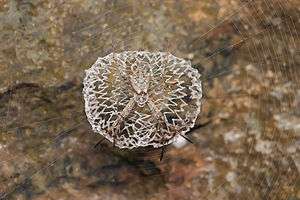
There are a few types of spider webs found in the wild, and many spiders are classified by the webs they weave. Different types of spider webs include:
- Spiral orb webs, associated primarily with the family Araneidae, as well as Tetragnathidae and Uloboridae[11]
- Tangle webs or cobwebs, associated with the family Theridiidae
- Funnel webs, with associations divided into primitive and modern
- Tubular webs, which run up the bases of trees or along the ground
- Sheet webs
Several different types of silk may be used in web construction, including a "sticky" capture silk and "fluffy" capture silk, depending on the type of spider. Webs may be in a vertical plane (most orb webs), a horizontal plane (sheet webs), or at any angle in between. It is hypothesized that these types of aerial webs co-evolved with the evolution of winged insects. As insects are spiders' main prey, it is likely that they would impose strong selectional forces on the foraging behavior of spiders.[3][12] Most commonly found in the sheet-web spider families, some webs will have loose, irregular tangles of silk above them. These tangled obstacle courses serve to disorient and knock down flying insects, making them more vulnerable to being trapped on the web below. They may also help to protect the spider from predators such as birds and wasps.[13]
Orb web construction
Most orb weavers construct webs in a vertical plane, although there are exceptions, such as Uloborus diversus, which builds a horizontal web.[14] During the process of making an orb web, the spider will use its own body for measurements.
Many webs span gaps between objects which the spider could not cross by crawling. This is done by first producing a fine adhesive thread to drift on a faint breeze across a gap. When it sticks to a surface at the far end, the spider feels the change in the vibration. The spider reels in and tightens the first strand, then carefully walks along it and strengthens it with a second thread. This process is repeated until the thread is strong enough to support the rest of the web.
After strengthening the first thread, the spider continues to make a Y-shaped netting. The first three radials of the web are now constructed. More radials are added, making sure that the distance between each radial and the next is small enough to cross. This means that the number of radials in a web directly depends on the size of the spider plus the size of the web. It is common for a web to be about 20 times the size of the spider building it.
After the radials are complete, the spider fortifies the center of the web with about five circular threads. It makes a spiral of non-sticky, widely spaced threads to enable it to move easily around its own web during construction, working from the inside outward. Then, beginning from the outside and moving inward, the spider methodically replaces this spiral with a more closely spaced one made of adhesive threads. It uses the initial radiating lines as well as the non-sticky spirals as guide lines. The spaces between each spiral and the next are directly proportional to the distance from the tip of its back legs to its spinners. This is one way the spider uses its own body as a measuring/spacing device. While the sticky spirals are formed, the non-adhesive spirals are removed as there is no need for them any more.
After the spider has completed its web, it chews off the initial three center spiral threads then sits and waits. If the web is broken without any structural damage during the construction, the spider does not make any initial attempts to rectify the problem.
The spider, after spinning its web, then waits on or near the web for a prey animal to become trapped. The spider senses the impact and struggle of a prey animal by vibrations transmitted through the web. A spider positioned in the middle of the web makes for a highly visible prey for birds and other predators, even without web decorations; many day-hunting orb-web spinners reduce this risk by hiding at the edge of the web with one foot on a signal line from the hub or by appearing to be inedible or unappetizing.
Spiders do not usually adhere to their own webs, because they are able to spin both sticky and non-sticky types of silk, and are careful to travel across only non-sticky portions of the web. However, they are not immune to their own glue. Some of the strands of the web are sticky, and others are not. For example, if a spider has chosen to wait along the outer edges of its web, it may spin a non-sticky prey or signal line to the web hub to monitor web movement. However, in the course of spinning sticky strands, spiders have to touch these sticky strands. They do this without sticking by using careful movements, dense hairs and nonstick coatings on their feet to prevent adhesion.[15]
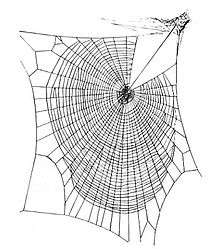 Zygiella orb web
Zygiella orb web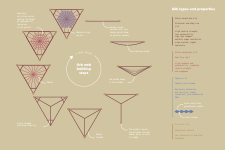 Infographic illustrating the process of constructing an orb web
Infographic illustrating the process of constructing an orb web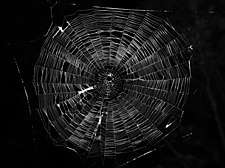
 Australian garden orb weaver spider, after having captured prey
Australian garden orb weaver spider, after having captured prey
Uses
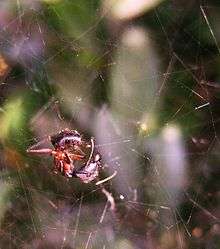
Some species of spider do not use webs for capturing prey directly, instead pouncing from concealment (e.g. trapdoor spiders) or running them down in open chase (e.g. wolf spiders). The net-casting spider balances the two methods of running and web spinning in its feeding habits. This spider weaves a small net which it attaches to its front legs. It then lurks in wait for potential prey and, when such prey arrives, lunges forward to wrap its victim in the net, bite and paralyze it. Hence, this spider expends less energy catching prey than a primitive hunter such as the wolf spider. It also avoids the energy loss of weaving a large orb web.
Some spiders spin threads of silk to catch the wind and then sail on the wind to a new location.
Some spiders manage to use the signaling-snare technique of a web without spinning a web at all. Several types of water-dwelling spiders rest their feet on the water's surface in much the same manner as an orb-web user. When an insect falls onto the water and is ensnared by surface tension, the spider can detect the vibrations and run out to capture the prey.
Human use
Cobweb paintings, which began during the 16th century in a remote valley of the Austrian Tyrolean Alps, were created on fabrics consisting of layered and wound cobwebs, stretched over cardboard to make a mat, and strengthened by brushing with milk diluted in water. A small brush was then used to apply watercolor to the cobwebs, or custom tools to create engravings. Fewer than a hundred cobweb paintings survive today, most of which are held in private collections.[16]
In traditional European medicine, cobwebs were used on wounds and cuts and seem to help healing and reduce bleeding.[17] Spider webs are rich in vitamin K, which can be effective in clotting blood. Webs were used several hundred years ago as pads to stop an injured person's bleeding.[18] The effects of some drugs can be measured by examining their effects on a spider's web-building.[19]
Spider web strands have been used for crosshairs or reticles in telescopes.[20]
Development of technologies to mass-produce spider silk has led to manufacturing of prototype military protection, medical devices, and consumer goods.[21]
Adhesive properties
The stickiness of spiders' webs is courtesy of droplets of glue suspended on the silk threads. This glue is multifunctional – that is, its behavior depends on how quickly something touching it attempts to withdraw. At high velocities, they function as an elastic solid, resembling rubber; at lower velocities, they simply act as a sticky glue. This allows them to retain a grip on attached food particles.[23] The web is electrically conductive which causes the silk threads to spring out to trap their quarry, as flying insects tend to gain a static charge which attracts the silk.[24]
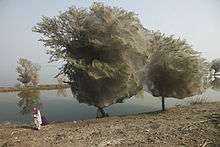
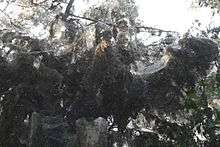
Communal spider webs
Occasionally, a group of spiders may build webs together in the same area.
Massive flooding in Pakistan during the 2010 monsoon drove spiders above the waterline, into trees. The result was trees covered with spider webs.[25]
One such web, reported in 2007 at Lake Tawakoni State Park in Texas, measured 200 yards (180 m) across. Entomologists believe it may be the result of social cobweb spiders or of spiders building webs to spread out from one another. There is no consensus on how common this occurrence is.[26]
In Brazil, there have been two instances of a phenomenon that became known as "raining spiders"; communal webs that cover such wide gaps and which strings are so difficult to see that hundreds of spiders seem to be floating in the air. The first occurred in Santo Antônio da Platina, Paraná, in 2013, and involved Anelosimus eximius individuals;[27] the second was registered in Espírito Santo do Dourado, Minas Gerais, in January 2019, and involved Parawixia bistriata individuals.[28]
Outside influences

Administering certain drugs to spiders affects the structure of the webs they build. It has been proposed by some that this could be used as a method of documenting and measuring the toxicity of various substances.[29][30]
Low gravity
It has been observed that being in Earth's orbit has an effect on the structure of spider webs in space.[31]
Spider webs were spun in low earth orbit in 1973 aboard Skylab, involving two female European garden spiders (cross spiders) called Arabella and Anita, as part of an experiment on the Skylab 3 mission.[32] The aim of the experiment was to test whether the two spiders would spin webs in space, and, if so, whether these webs would be the same as those that spiders produced on Earth. The experiment was a student project of Judy Miles of Lexington, Massachusetts.[32]
After the launch on July 28, 1973, and entering Skylab, the spiders were released by astronaut Owen Garriott into a box that resembled a window frame.[32] The spiders proceeded to construct their web while a camera took photographs and examined the spiders' behavior in a zero-gravity environment. Both spiders took a long time to adapt to their weightless existence. However, after a day, Arabella spun the first web in the experimental cage, although it was initially incomplete.
.jpg)
The web was completed the following day. The crew members were prompted to expand the initial protocol. They fed and watered the spiders, giving them a house fly.[33] The first web was removed on August 13 to allow the spider to construct a second web. At first, the spider failed to construct a new web. When given more water, it built a second web. This time, it was more elaborate than the first. Both spiders died during the mission, possibly from dehydration.[32]
When scientists were given the opportunity to study the webs, they discovered that the space webs were finer than normal Earth webs, and although the patterns of the web were not totally dissimilar, variations were spotted, and there was a definite difference in the characteristics of the web. Additionally, while the webs were finer overall, the space web had variations in thickness in places: some places were slightly thinner, and others slightly thicker. This was unusual, because Earth webs have been observed to have uniform thickness.[34]
In popular culture
Spider webs play a crucial role in the children's novel Charlotte's Web. Webs are also featured in many other cultural depictions of spiders. In films, illustration, and other visual arts, spider webs may be used to readily suggest a "spooky" atmosphere, or imply neglect or the passage of time. Artificial "spider webs" are a common element of Halloween decorations. Spider webs are a common image in tattoo art, often symbolizing long periods of time spent in prison, or used simply to fill gaps between other images.
Some observers believe that a small spider is depicted on the United States one-dollar bill, in the upper-right corner of the front side (obverse), perched on the shield surrounding the number "1". This perception is enhanced by the resemblance of the background image of intertwining fine lines to a stylized spider web. However, other observers believe the figure is an owl.[35]
Artificial spider webs are used by the superhero Spider-Man to restrain enemies and to make ropes on which to swing between buildings as quick transportation. Some incarnations of the character, such as the one in the original film trilogy and Spider-Man 2099, shoot natural webs, generated by spinneret-like organs in their forearms.
The World Wide Web is thus named because of its tangled and interlaced structure, said to resemble that of a spider web.
The notable tensile strength of spider webs is often exaggerated in science fiction, often as a plot device to justify the presence of artificially giant spiders.
See also
References
- "Oxford Dictionaries - The World's Most Trusted Dictionary Provider". Oxford Dictionaries. Retrieved 16 March 2018.
- Brasier, Cotton & Yenney 2009
- Vollrath, F.; Selden, P. (December 2007). "The role of behavior in the evolution of spiders, silks, and webs". Annu. Rev. Ecol. Evol. Syst. 38: 819–46. doi:10.1146/annurev.ecolsys.37.091305.110221.
- O.E.D.
- Kaston, B.J. (May 1964). "The evolution of spider webs". American Zoologist. 4 (2): 191–207. doi:10.1093/icb/4.2.191. JSTOR 3881292.
- Blackedge, T. A.; Scharff, N.; Coddington, J. A.; Szuts, T.; Wenzel, J. W.; Hayashi, C. Y.; Agnarsson, I. (2009). "Reconstructing web evolution and spider diversification in the molecular era". Proceedings of the National Academy of Sciences of the United States of America. 106 (13): 5229–34. Bibcode:2009PNAS..106.5229B. doi:10.1073/pnas.0901377106. PMC 2656561. PMID 19289848.
- Craig, C. L. (1997). "Evolution of arthropod silks". Annual Review of Entomology. 42: 231–67. doi:10.1146/annurev.ento.42.1.231. PMID 15012314.
- "GM goat spins web based future". BBC News. 21 August 2000. Retrieved 2008-01-06.
- Becker, Nathan; Oroudjev, Emin; Mutz, Stephanie; Cleveland, Jason P.; Hansma, Paul K.; Hayashi, Cheryl Y.; Makarov, Dmitrii E.; Hansma, Helen G. (2003). "Molecular nanosprings in spider capture-silk threads". Nature Materials. 2 (4): 278–83. Bibcode:2003NatMa...2..278B. doi:10.1038/nmat858. PMID 12690403.
- Connor, Steve (18 January 2002). "A spider's web that could catch an F-16". The Independent. Independent News and Media Limited. Archived from the original on 22 January 2008. Retrieved 2008-01-06.
- Bond, J. E.; Opell, B. D. (1998). "Testing adaptive radiation and key innovation hypotheses in spiders". Evolution. 52 (2): 403–14. doi:10.2307/2411077. JSTOR 2411077.
- Penalver, E.; Grimaldi, D. A.; Delclos, X. (2006). "Early Cretaceous spider web with its prey". Science. 312 (5781): 1761–61. doi:10.1126/science.1126628. PMID 16794072.
- Blackledge, T.A.; Coddington, J.A.; Gillespie, R.G. (January 2003). "Are three-dimensional spider webs defensive adaptations?". Ecology Letters. 6 (1): 13–18. doi:10.1046/j.1461-0248.2003.00384.x.
- "Uloborus diversus". Table Grape Spider ID. Retrieved 2017-06-10.
- Briceno, R.; Eberhard, W. (2012). "TSpiders avoid sticking to their webs: clever leg movements, branched drip-tip setae, and anti-adhesive surfaces". Naturwissenschaften. 99 (4): 337–41. Bibcode:2012NW.....99..337B. doi:10.1007/s00114-012-0901-9. PMID 22382404.
- Hock, Lauren (November 13, 2008). "Cobweb Art a Triumph of Whimsy Over Practicality". Northwestern University. Retrieved 2008-11-13.
- "German pharmacist used cobwebs". Channel 4. September 10, 2008. Archived from the original on June 16, 2008. Retrieved 2008-09-10.
- "Chance meeting leads to creation of antibiotic spider silk". phys.org. Retrieved 2019-09-13.
- Jackson, Robert R (1974). "Effects of D-Amphetamine Sulphate and Diasepam on Thread Connection Fine Structure in a Spider's Web" (PDF). North Carolina Department of Mental Health.
- The Tommy Dot: Example of using spider silk for telescopic rifle sights. Popular Science. April 1955. p. 216. Retrieved 27 November 2017.
- Service, Robert F. (18 October 2017). "Spinning spider silk into startup gold". Science Magazine, American Association for the Advancement of Science. Retrieved 26 November 2017.
- Zhao, Yue; Morita, Masato; Sakamoto, Tetsuo (2019). "Loss of phosphate determines the versatility of a spider orb-web glue ball". Analytical Sciences. 35 (6): 645–649. doi:10.2116/analsci.18P480. ISSN 0910-6340. PMID 30773509.
- Sahni, Vasav; Blackledge, Todd A.; Dhinojwala, Ali (2010). "Viscoelastic solids explain spider web stickiness". Nature Communications. 1 (2): 1. Bibcode:2010NatCo...1E..19S. doi:10.1038/ncomms1019. PMID 20975677.
- Whipple, Tom (17 January 2014). "The shocking secret of a spider's web". The Times: Nature. Times Newspapers Limited. Retrieved 20 January 2014.
- Than, Ker (31 March 2011). "Trees Cocooned in Webs After Flood". National Geographic.
- "Spider web engulfs Texas park trail". Associated Press. August 30, 2007. Retrieved 2007-08-30.
- Nuwer, Rachel (18 February 2013). "It's Raining Spiders in Brazil". Smithsonian. Smithsonian Institution. Retrieved 21 February 2019.
- Kaiser, Anna Jean (11 January 2019). "'Raining spiders': airborne arachnids appear over south-east Brazil". The Guardian. Guardian Media Group. Retrieved 21 February 2019.
- Noever, R.; Cronise, J.; Relwani, R.A. (1995). "Using spider-web patterns to determine toxicity". NASA Tech Briefs. 19 (4): 82.
- "Spiders on speed get weaving". New Scientist. 29 April 1995. Retrieved 2006-09-08.
- Witt, P.N.; Scarboro, M.B.; Peakall, D.B.; Gause, R. (1976). "Spider web-building in outer space: Evaluation of records from the Skylab spider experiment" (PDF). J. Arachnol. 4 (2): 115.
- Burgess, Colin; Dubbs, Chris (2007). Animals in Space: From Research Rockets to the Space Shuttle. Chichester UK: Praxis. pp. 323–26. ISBN 978-0-387-36053-9.
- "Spiders in Space on Skylab 3". About.com. Retrieved 2010-08-13.
- "Guinness World Records". www.guinnessworldrecords.com. Retrieved 2017-12-23.
- "Top 10 Images Hidden on the One Dollar Bill". Terrific Top 10. 2013-11-12. Retrieved 2017-12-23.

